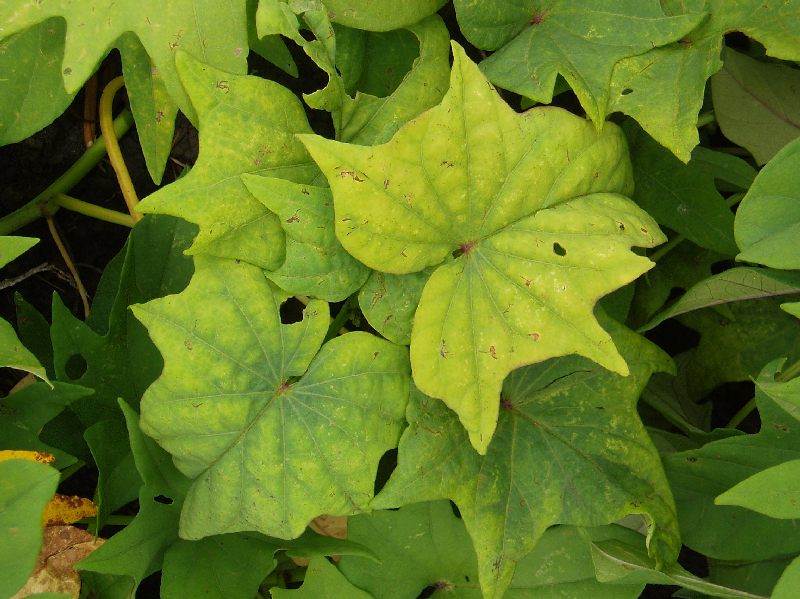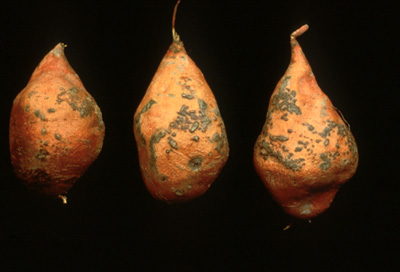|
Sweetpotato
seems to be more susceptible to boron (B) deficiency
than many other crops. Boron deficiency has long been recognised as a
significant problem of commercial sweetpotato crops in the USA, particularly as
a cause of poor root quality. Cases have been recorded in many other countries,
in a range of environments.
Boron deficiency affects actively growing
tissue, both of the shoot and the roots. The first sign is usually a thickening
of young leaves. The leaves and stem near the shoot tip are brittle and break
easily when bent. Other symptoms are variable, depending on the cultivar and
growing conditions. Young leaves are usually paler than the older leaves
but the extent and pattern of chlorosis
is variable: it may be uniform, or diffusely interveinal, fading gradually with
distance from the main veins. In other cases it may be a less distinct interveinal
mottle. Leaves may become puckered
(slightly raised in interveinal zones) and the tip and lateral lobes may curl
down. Petioles may twist. Internodes may be shortened, producing a compact
habit around the apex. In some cases, the leaf veins may appear thickened, bumpy
or even callused. Deeply lobed cultivars may display
reduced development of the lateral lobes.
At greater severity, B deficiency causes
death of the growing points. The dominant tip is usually the first affected, but
the axillary buds also become necrotic.
Fibrous roots of B-deficient sweetpotato
plants become short, stumpy and highly branched, producing the coral-like
structures typical of B deficiency in many plant species.
Storage roots are often short and blunt-ended, and may have an increased
incidence of splitting. Splits formed early in development tend to look
healed and overgrown. The skin may be rough and may wrinkle
towards the ends. The cut root exudes less white sap than normal, and the flesh
may be mottled or corky in places. Orange-fleshed roots are generally paler than
normal. The flavour is less sweet, or even bitter. Some cultivars may display
irregular thickening of roots, resulting in dumbbell and spindle shapes. Other
disorders reported to be associated with B deficiency are “internal brown spot”
and “sweetpotato blister”. Internal brown spot is characterised by the
occurrence of brown necrotic areas in the flesh, irregularly distributed but
more prevalent in the cambial zone, close to the surface of the root.
Sweetpotato blister refers to raised dark spots which develop on the skin of
some cultivars following a period of storage, and may be sparsely scattered or
numerous, covering a large proportion of the root surface.
Storage
root development may be severely reduced or completely inhibited by severe B
deficiency.
Symptoms on foliage might resemble those of false spider mite, zinc
deficiency or mild iron deficiency.
Blister-like bumps and cracking of storage roots can be symptoms of
root-knot nematode. Rapid changes in soil moisture can also cause
cracking. Cold soil or storage temperatures might also cause the
absence of latex sap and mottled, poor-textured flesh.
Calcium deficiency may also result in the
death of shoot and root tips. However, in the case of Ca deficiency, young
leaves below the shoot tip are not thickened but develop a necrosis which
spreads from the lateral margins.
A critical concentration of 40 mg B/kg in
the 7th to 9th youngest leaf blades was determined in solution culture studies
using cv. Wanmun. This seems to coincide well with field observations on a wide
range of cultivars.
With regard to soil analyses, the
relationship between hot water extractable B and B deficiency is modified by a
number of factors including soil texture, pH and available Ca. There is no
published information on soil B in relation to B deficiency in sweetpotato.
Critical concentrations quoted in the literature for a wide range of crops
mostly lie in the range 0.3-0.5 mg/kg hot water extractable B, but may be up to
1 mg/kg for susceptible species such as beet, and may be higher in alkaline
soils than in acid soils.
Cultural control
Application of borax or other borates (eg.
“Solubor”) to the soil before planting. Recommended rates are 1-1.5 kg B/ha
on sandy, acid soils, or up to 4 kg B/ha on clayey, alkaline soils.
Overfertilisation may result in B toxicity, so it is best to aim for the lowest
effective rate, which may be further reduced on subsequent crops.
Foliar application of B is often recommended
for other crops, as it allows lower dose rates with less risk of accumulation in
the soil. However, it is unclear whether foliar treatment is effective for
sweetpotato. Boron is not readily transported within the plant from vines to
roots, and while the tops may appear healthy after foliar spraying, symptoms may
persist on the storage roots. The mixed reports from this method may depend on
how much of the B is subsequently washed onto the soil.
Bourke, R.M. 1983. Crop micronutrient deficiencies in Papua New
Guinea. Technical Report 83/3, Department of Primary Industry, Papua New Guinea.
Bradford, G.R. 1966. Boron. In: Chapman, H.D. (ed.) Diagnostic
criteria for plants and soils. University of California, Riverside. pp 33-61.
Miller, C.H. and Nielsen, L.W. 1970. Sweet potato blister, a
disease associated with boron deficiency. Journal of the American Society for
Horticultural Science 95, 685-686.
Nusbaum, C.J. 1946. Internal brown spot, a boron deficiency
disease of sweet potato. Phytopathology 36, 164-167.
O’Sullivan,
J.N., Asher, C.J. and Blamey, F.P.C.1997. Nutrient Disorders of Sweet Potato.
ACIAR Monograph No. 48, Australian Centre for International Agricultural
Research, Canberra, 136 p.
O’Sullivan, J., Loader, L., Asher, C., Blamey, P. 1997b.
Troubleshooting nutritional problems in a new industry: sweet potato in North
Queensland. Proceedings of the First Australian New Crops Conference, Gatton,
July 1996. Rural Industries Research and Development Corporation, Australia.
Pillai, N.G., Mohankumar, B., Kabeerathumma, S. and Nair, P.G.
1986. Deficiency symptoms of micronutrients in sweet potato (Ipomoea batatas L.).
Journal of Root Crops 12 (2), 91-95.
von Stieglitz, C.R. and Chippendale, F. 1955. Nutritional
Disorders of Plants. Queensland Department of Agriculture and Stock.
Willis, L.G. 1943. Apply borax to improve quality of sweet potatoes. North Carolina
Agricultural Experiment Station Special Circular 1, 1943.
Contributed
by:
Jane O'Sullivan
|
Characteristics
and occurrence
Symptoms
Confusion
with other symptoms
Diagnostic
tests
Management
References

Compact growth, mottled chlorosis, mild
puckering and downward curling of young leaves on a B-deficient plant in PNG
(J. O'Sullivan).

Deformity of a young leaf, including thickening,
reduction in lobes and irregular margins (J. O'Sullivan).
 
Boron-deficient leaves generally become thickened and brittle, and tend
to curl downwards. Tip death is common (J. O'Sullivan).

Symptoms on a B-deficient crop in PNG, including small tubers with
splits, vine tip death and small, thickened, chlorotic young leaves (R.M.
Bourke).

A vine showing short internodes to the right of marker, and lengthened
internodes on growth since boron was applied (L. Loader).

Short, blunt-ended roots from a B-deficient crop (left) and normal,
spindle-shaped roots developing on a younger crop to which boron was applied
(L. Loader).

Healed and overgrown cracks on B deficient storage roots (C.
Asher).

Blisters
on storage roots caused by boron deficiency (C. Clark, APS).

Short, highly branched lateral roots with thickened, clublike ends are
characteristic of severe boron deficiency (J. O'Sullivan). |

